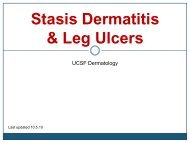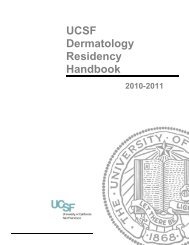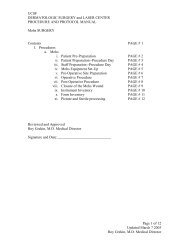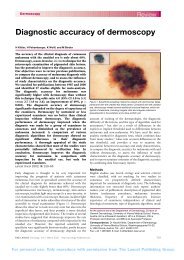An overview of sexually transmitted diseases. Part III ... - Dermatology
An overview of sexually transmitted diseases. Part III ... - Dermatology
An overview of sexually transmitted diseases. Part III ... - Dermatology
Create successful ePaper yourself
Turn your PDF publications into a flip-book with our unique Google optimized e-Paper software.
J AM ACAD DERMATOL<br />
VOLUME 43, NUMBER 3<br />
Imiquimod has been studied in AIDS patients and<br />
certainly deserves consideration as a potential therapy.<br />
213 Crude podophyllin extract might be a poor<br />
choice in an HIV-infected patient, given the predisposition<br />
for the development <strong>of</strong> cancer in these<br />
patients and podophyllin’s link to the mutagens<br />
quercetin and kaempherol. 165 Cid<strong>of</strong>ovir is a<br />
nucleotide analog that is used most commonly for<br />
the treatment <strong>of</strong> cytomegalovirus retinitis in AIDS<br />
patients. 214 Because <strong>of</strong> its activity against DNA viruses,<br />
it may be effective as either an intravenous or topical<br />
therapy for recalcitrant mollusca. A recent case<br />
report describes resolution <strong>of</strong> extensive facial lesions<br />
in 3 AIDS patients after beginning either intravenous<br />
or topical cid<strong>of</strong>ovir therapy. 215 The authors <strong>of</strong> this<br />
report point out that the patients’ improvement<br />
most closely correlates with the use <strong>of</strong> cid<strong>of</strong>ovir, but<br />
that it is impossible to exclude the possible immune<br />
system–enhancing effects <strong>of</strong> antiretroviral therapy.<br />
At least 3 case reports describe the reduction in<br />
number <strong>of</strong> patients’ extensive mollusca after beginning<br />
potent combination antiretroviral treatment.<br />
190,216,217 In one early case, a patient improved<br />
after initiation <strong>of</strong> zidovudine, 190 and in a more recent<br />
case, a patient improved after starting ritonavir. 216<br />
This highlights an important point: every attempt<br />
should be made to optimize treatment <strong>of</strong> the HIV<br />
infection in patients afflicted with molluscum contagiosum<br />
because this will make treatment <strong>of</strong> the molluscum<br />
contagiosum infection more feasible. 218<br />
HUMAN HERPESVIRUS 8<br />
Human herpesvirus 8 (HHV-8), formerly known<br />
as Kaposi’s sarcoma–associated herpesvirus, was<br />
originally identified in Kaposi’s sarcoma (KS) from<br />
AIDS patients. 221 It has been linked with all other<br />
forms <strong>of</strong> KS as well. 222-226 HHV-8 is also associated<br />
with a rare type <strong>of</strong> non-Hodgkin’s lymphoma,<br />
termed primary effusion lymphoma, 227,228 and with<br />
the plasma cell variant <strong>of</strong> Castleman’s disease. 229,230<br />
Furthermore, patients with HIV-associated KS are at<br />
a significantly greater risk for the development <strong>of</strong><br />
non-Hodgkin’s lymphoma than their unaffected<br />
counterparts. 231-234 Schwartz 235 discussed the major<br />
issues relating to KS in a comprehensive review, and<br />
a similar discussion would be inappropriate here.<br />
Although the biology <strong>of</strong> HHV-8 is not entirely understood,<br />
it appears to be a <strong>sexually</strong> <strong>transmitted</strong> infection<br />
in the United States and Western Europe.<br />
Most cases <strong>of</strong> AIDS-associated KS have appeared<br />
in men who participated in promiscuous homosexual<br />
activities or had a history <strong>of</strong> STDs. 236-244<br />
Furthermore, homosexual men whose partners live<br />
in areas <strong>of</strong> high HHV-8 prevalence, such as San<br />
Francisco or New York City, appear to be at an<br />
Czelusta, Yen-Moore, and Tyring 421<br />
Table <strong>III</strong>. Treatment modalities for molluscum<br />
contagiosum<br />
Surgical<br />
Curettage 192,209<br />
Electrodesiccation 192,218<br />
Cryotherapy 219<br />
Laser surgery 220<br />
Cytodestructive<br />
Cantharadin 192<br />
Iodine 192,218<br />
Lactic acid 207<br />
Phenol 192,207<br />
Salicylic acid 207<br />
Silver nitrate 192<br />
Tretinoin 192<br />
Trichloroacetic acid 210<br />
Chemotherapeutic/antiviral<br />
Cid<strong>of</strong>ovir 215<br />
Interferon 211,212<br />
Imiquimod 213<br />
increased risk <strong>of</strong> acquiring the virus. Those persons<br />
who acquired HIV non<strong>sexually</strong> (eg, hemophiliacs or<br />
intravenous drug abusers) have much lower rates <strong>of</strong><br />
KS than those people who contracted HIV from<br />
homosexual or bisexual contacts.<br />
Many studies have focused on shedding <strong>of</strong> HHV-8<br />
into semen with variable results. Most studies were<br />
unable to detect HHV-8 in either the semen <strong>of</strong><br />
healthy patients or HIV patients, 245-249 and detection<br />
<strong>of</strong> HHV-8 in the semen <strong>of</strong> patients with KS proved<br />
similarly difficult. However, two controversial studies<br />
reported high rates <strong>of</strong> HHV-8 in the semen <strong>of</strong><br />
healthy patients. 250,251 Oral secretions in patients<br />
with KS appear to consistently shed HHV-8 virions.<br />
252,253 Other suggested, but less investigated<br />
methods <strong>of</strong> transmission, include oral-anal contacts<br />
or exposure to feces. 254-256 Further investigation<br />
regarding this virus, its transmission, and its relationship<br />
to HIV is indicated.<br />
KS was originally described in HIV-seronegative<br />
persons (ie, classic KS). This form usually presents as<br />
purple plaques or papules on the lower extremities<br />
<strong>of</strong> elderly men <strong>of</strong> Mediterranean and/or Jewish<br />
decent. Patients with classic KS may die with this sarcoma<br />
but rarely die from it. In HIV-positive persons,<br />
however, a much wider variety <strong>of</strong> lesions (eg, patches,<br />
plaques, papules, nodules, ulcers) may appear<br />
anywhere on the skin or mucous membranes (Fig<br />
10). Visceral involvement <strong>of</strong> KS is common in HIVseropositive<br />
persons and is associated with significant<br />
morbidity and mortality. KS has been much less<br />
common in the past 3 years since the availability <strong>of</strong><br />
highly active antiretroviral therapy (HAART), which

















